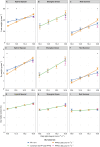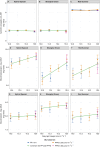Extended photoperiod improves growth and nutritional quality of pak choi under constant daily light integral
- PMID: 40831726
- PMCID: PMC12358294
- DOI: 10.3389/fpls.2025.1621513
Extended photoperiod improves growth and nutritional quality of pak choi under constant daily light integral
Abstract
Introduction and aim: The duration of light exposure each day, termed the photoperiod, is a crucial environmental cue that influence several aspects of plant physiology, including growth, development, and metabolic activity. Adjusting the photoperiod in controlled agriculture systems has the potential to improve crop yield and nutritional content. However, the benefits of longer photoperiods compared to higher light intensities under a fixed daily light integral (DLI) have not been thoroughly examined for many leafy vegetables. DLI is the total amount of light a plant receives per day and it is the product of photoperiod and light intensity. This study aimed to determine to what extent the effect of DLI on pak choi (Brassica rapa L. subsp. chinensis) growth, yield and quality depends on whether DLI is changed by light intensity (PPFD) or by photoperiod.
Methods: Three cultivars ('Hybrid Special', 'Red Summer', and 'Shanghai Green') were grown under four different DLIs (10.8, 13.5, 16.2, and 18.9 mol m-2 d-1). These DLIs were achieved either by varying the photoperiod (12, 15, 18 and 21 hours) at a constant PPFD 250 µmol m-2 s-1 or by varying the PPFD (167, 208, 250, and 292 µmol m-2 s-1) at a constant photoperiod (18 hours).
Results: Increasing DLI by extending the photoperiod resulted in more growth than increasing DLI by increasing PPFD. Photoperiod extension also generally resulted in higher light use efficiency and energy use efficiency than increasing DLI by increasing PPFD. The content of vitamin C, glucosinolates and many other metabolites increased significantly with higher DLI regardless whether DLI was increased through PPFD or photoperiod. However, DLI did not affect shelf life and overall visual quality.
Discussion: These results suggest that extending photoperiod is a more effective strategy than increasing light intensity for optimizing leafy vegetable production in controlled environments.
Keywords: LUE; PSM; light intensity; pak choi; photoperiod; sole LED lights; vitamin C.
Copyright © 2025 Susilo, Eu, Besemer, Heuvelink, de Vos and Marcelis.
Conflict of interest statement
The authors declare that the research was conducted in the absence of any commercial or financial relationships that could be construed as a potential conflict of interest. The author(s) declared that they were an editorial board member of Frontiers, at the time of submission. This had no impact on the peer review process and the final decision.
Figures








Similar articles
-
Prescription of Controlled Substances: Benefits and Risks.2025 Jul 6. In: StatPearls [Internet]. Treasure Island (FL): StatPearls Publishing; 2025 Jan–. 2025 Jul 6. In: StatPearls [Internet]. Treasure Island (FL): StatPearls Publishing; 2025 Jan–. PMID: 30726003 Free Books & Documents.
-
Intravenous magnesium sulphate and sotalol for prevention of atrial fibrillation after coronary artery bypass surgery: a systematic review and economic evaluation.Health Technol Assess. 2008 Jun;12(28):iii-iv, ix-95. doi: 10.3310/hta12280. Health Technol Assess. 2008. PMID: 18547499
-
The Black Book of Psychotropic Dosing and Monitoring.Psychopharmacol Bull. 2024 Jul 8;54(3):8-59. Psychopharmacol Bull. 2024. PMID: 38993656 Free PMC article. Review.
-
A rapid and systematic review of the clinical effectiveness and cost-effectiveness of paclitaxel, docetaxel, gemcitabine and vinorelbine in non-small-cell lung cancer.Health Technol Assess. 2001;5(32):1-195. doi: 10.3310/hta5320. Health Technol Assess. 2001. PMID: 12065068
-
Systemic pharmacological treatments for chronic plaque psoriasis: a network meta-analysis.Cochrane Database Syst Rev. 2021 Apr 19;4(4):CD011535. doi: 10.1002/14651858.CD011535.pub4. Cochrane Database Syst Rev. 2021. Update in: Cochrane Database Syst Rev. 2022 May 23;5:CD011535. doi: 10.1002/14651858.CD011535.pub5. PMID: 33871055 Free PMC article. Updated.
References
-
- Ahamed M. S., Sultan M., Monfet D., Rahman M. S., Zhang Y., Zahid A., et al. (2023). A critical review on efficient thermal environment controls in indoor vertical farming. J. Cleaner Production 425, 138923. doi: 10.1016/j.jclepro.2023.138923 - DOI
-
- Avgoustaki D. D., Xydis G. (2020). Plant factories in the water-food-energy Nexus era: A systematic bibliographical review. Food Secur. 12, 253–268. doi: 10.1007/s12571-019-01003-z - DOI
-
- Birlanga V., Acosta-Motos J. R., Pérez-Pérez J. M. (2021). Genotype-dependent tipburn severity during lettuce hydroponic culture is associated with altered nutrient leaf content. Agronomy 11. doi: 10.3390/agronomy11040616 - DOI
LinkOut - more resources
Full Text Sources
Miscellaneous

